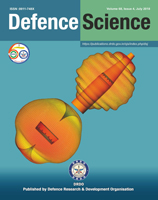Application of Spatiotemporal Fuzzy C-Means Clustering for Crime Spot Detection
DOI:
https://doi.org/10.14429/dsj.68.12518Keywords:
Fuzzy clustering, spatiotemporal data, crime dataAbstract
The various sources generate large volume of spatiotemporal data of different types including crime events. In order to detect crime spot and predict future events, their analysis is important. Crime events are spatiotemporal in nature; therefore a distance function is defined for spatiotemporal events and is used in Fuzzy C-Means algorithm for crime analysis. This distance function takes care of both spatial and temporal components of spatiotemporal data. We adopt sum of squared error (SSE) approach and Dunn index to measure the quality of clusters. We also perform the experimentation on real world crime data to identify spatiotemporal crime clusters.
References
K.P. Agrawal, S.Garg, S. Sharma and P. Patel, “Development and validation of OPTICS based spatio-temporal clustering technique”, Information Sciences, vol. 369, pp.388-401,2016.
S. Kisilevich, F. Mansmann, M. Nanni, and S. Rinzivillo, “Spatiotemporal clustering,” in Data mining and Knowledge Discovery Handbook. New York: Springer, pp. 855–874, 2010.
H. Izakian, S. Member, W. Pedrycz, and I. Jamal, “Clustering Spatiotemporal Data : An Augmented F. C-means”, IEEE Transactions on Fuzzy Systems, vol. 21, no. 5, pp. 855–868, 2013.
H. F. Tork, “Spatio-Temporal Clustering Methods Classification,” Doctoral Symposium on Informatics Engineering, pp. 199-209, 2012.
U. Kaymak and M. Setnes, “Fuzzy clustering with volume proto type and adaptive cluster merging”, IEEE Transactions on Fuzzy Systems, vol.10, no.6, pp. 705–712.
J. Wu, H. Xiong, C. Liu, and J. Chen, “A generalization of distance functions for fuzzy C-means clustering with centroids of arithmetic means,” IEEE Trans. Fuzzy Syst., vol. 20, no. 3, pp. 557–571, Jun. 2012.
F. Di Martino and S. Sessa, “The extended fuzzy C-means algorithm for hotspots in spatio-temporal GIS”, Expert Systems with Application., vol. 38, no. 9, pp. 11829–11836, 2011.
H. Cao, H. W. Deng, and Y. P. Wang, “Segmentation of M-FISH images for improved classification of chromosomes with an adaptive fuzzy C means clustering algorithm,” IEEE Trans. Fuzzy Syst., vol. 20, no. 1,pp. 1–9, Feb. 2012.
J. P. Mei and L. Chen, “A fuzzy approach for multitype relational data clustering,” IEEE Trans. Fuzzy Syst., vol. 20, no. 2, pp. 358–371, Apr.2012.
M.Kulldorff, “Prospective time periodic geographical disease surveillance using a scan statistic,” J. Roy. Statist. Soc. A, vol. 164, no. 1, pp. 61–72,2001.
N. Malleson and M. A. Andresen, “Spatio-temporal crime hotspots and the ambient population,” Crime Science., vol. 4, no. 1, p. 10, 2015.
Z. Liu and R. George, “Fuzzy cluster analysis of spatio-temporal data,” in Proc. 18th Int. Symp. Comput. Inf. Sci., Antalya, Turkey, 2003, pp. 984–991.
M. Ji, F. Xie, and Y. Ping, “A Dynamic Fuzzy Cluster Algorithm for Time Series,” Abstract and Applied. Analysis, vol. 2013, 2013.
D. Mayorga, M. A. Melgarejo, and N. Obregon, “A Fuzzy Clustering Based Method For the Spatiotemporal Analysis of Criminal Patterns”, IEEE International Conference on Fuzzy Systems (FUZZ-IEEE), pp. 738–744, 2016.
D.T. Larose, “Discovering Knowledge in Data: An Introduction to Data Mining”, ISBN 0-471-66657-2,John Wiley & Sons, Inc, 2005.
The home of the U.S. Government’s open data. https://www.data.gov/ (accessed on 26-11-2017 )
Downloads
Published
How to Cite
Issue
Section
License
 Where otherwise noted, the Articles on this site are licensed under Creative Commons License: CC Attribution-Noncommercial-No Derivative Works 2.5 India
Where otherwise noted, the Articles on this site are licensed under Creative Commons License: CC Attribution-Noncommercial-No Derivative Works 2.5 India


